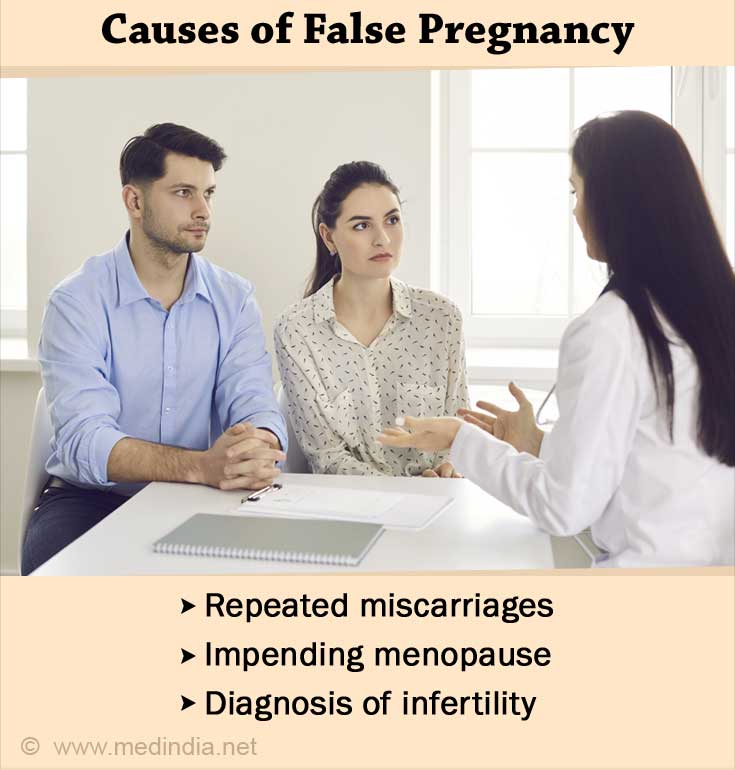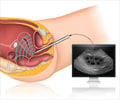- False pregnancy - (http://en.wikipedia.org/wiki/false_pregnancy)
What is False Pregnancy?
False pregnancy (or “pseudocyesis”) is the presence of clinical signs and symptoms associated with pregnancy without actually being pregnant. Phanthom pregnancy and hysterical pregnancy are older terms used to refer to pseudocyesis. When the false signs and symptoms of pregnancy are seen in mammals other than human beings, the term is referred to as pseudo pregnancy. Dogs and mice are the most commonly seen mammals presenting with false pregnancy.
False pregnancy in men is also possible and could be caused by pheromones (chemicals that help communicate to change the behavior of other animals of the same species) that specifically increase estrogen, prolactin and cortisol levels. Pseudocyesis in men is more common if their partner is expecting a baby and such a condition is called the Couvade syndrome.
The person with pseudocyesis believes that she or he is expecting a baby when they are not really carrying a child. Most of the symptoms of pregnancy occur in pseudocyesis with the exception that there is no fetus in the uterus. It is different from malingering in which a woman knows that she is not pregnant but feigns pregnancy for certain benefits. Pseudocyesis excludes delusions of pregnancy that may occur in schizophrenia or any other related psychotic disorders.
What are the Causes of False Pregnancy?
Doctors suspect that some types of psychological factors may trigger the body to believe that it is pregnant. The condition can be a result of the woman feeling an intense desire to get pregnant. This desire in turn can be triggered due to –
- Repeated miscarriages
- Impending menopause
- Pressure from family to have a child
- Desire to get married
- Diagnosis of infertility

- Factors like poverty, lack of education, sexual abuse in early life and interpersonal relationships can also be a cause of pseudocyesis.
- Some of the pregnancy signs may occur in a woman with a strong desire to get pregnant. They may be enlarged breasts, interruption of the menstrual period or even feeling fetal movements. The brain misinterprets these signs as pregnancy and releases the relevant hormones such as estrogen and prolactin, which further enhance the symptoms of pregnancy.
What are the Symptoms and Signs of False Pregnancy?
The symptoms of false pregnancy are almost the same as a natural pregnancy with the exception of the absence of the fetus. They include:
- Swollen abdomen and abdominal distension
- Feeling of fetal movements
- Interruption of menstrual period
- Morning sickness
- Nausea and vomiting
- Weight gain
- Enlarged breasts and tenderness, changes in the nipples
- Sometimes milk production
- Rarely a person may arrive at the doctor’s office with what feels like labor pains
Symptoms in a false pregnancy can last for a few weeks, for nine months or sometimes for several years.

How to Diagnose False Pregnancy?
A doctor evaluates symptoms of pregnancy, performs a pelvic exam and abdominal ultrasound, as performed for a real pregnancy.
Physical examination may reveal uterine enlargement and softening of the cervix, similar to the pregnancy symptoms. Urine pregnancy tests will be negative, except for rare cancers that can produce hormones similar to pregnancy.
Pregnancy ultrasound tests can reveal the absence of the formation of the fetus and the heartbeats.

Other medical conditions that mimic symptoms of pregnancy include ectopic pregnancy morbid obesity and cancer. These conditions can be easily identified in a regular or specialized pregnancy ultrasound scan.
Diagnosis of false pregnancy must be done after ruling out delusions of pregnancy. In delusions, the pregnancy-like changes in the body are not seen, while pseudocyesis presents with the exact somatic symptoms of pregnancy except for the absence of the fetus.
What is the Treatment for False Pregnancy?
Breaking the news of absence of pregnancy to a woman who believes that she is pregnant can be a challenge for the doctors. If the doctor tries to convince that the woman has tested negative in the urine test, she would argue to claim that it could be a false negative pregnancy test. A confirmatory serum pregnancy test is often performed to strengthen the diagnosis. It is important that the underlying cause of the condition is identified and handled with care.
The person needs psychological support such as counseling and cognitive behavioral therapy for handling the situation that has given rise to the need to believe that she is pregnant. Sometimes antidepressants are also given.

Pseudopregnancy in Other Mammals:
Some animals may present false pregnancy due to the corpus luteum. The remains of the ovulated ovarian follicle, called corpus luteum, trigger brain to produce hormones and cause development of maternal behavior and lactation.
Pseudo pregnancy is seen to occur in dogs, cats, mice and swine. They manifest the signs of pregnancy following an estrus phase (sexually receptive phase) in which the female either has not been bred or mated with an infertile male. The corpus luteum triggers the production of progesterone and development of characteristics and behaviours required for the care of the offspring.










